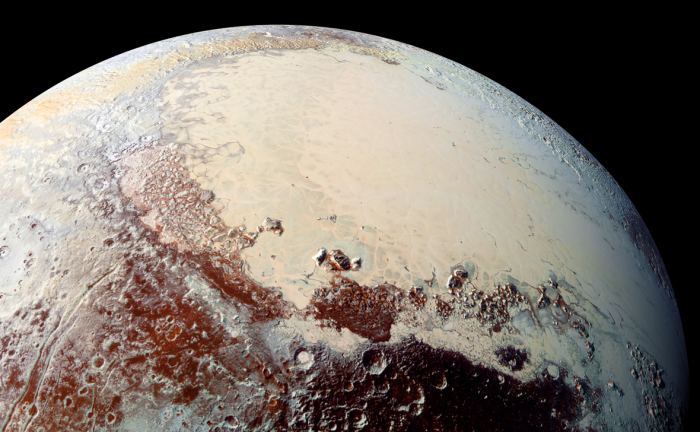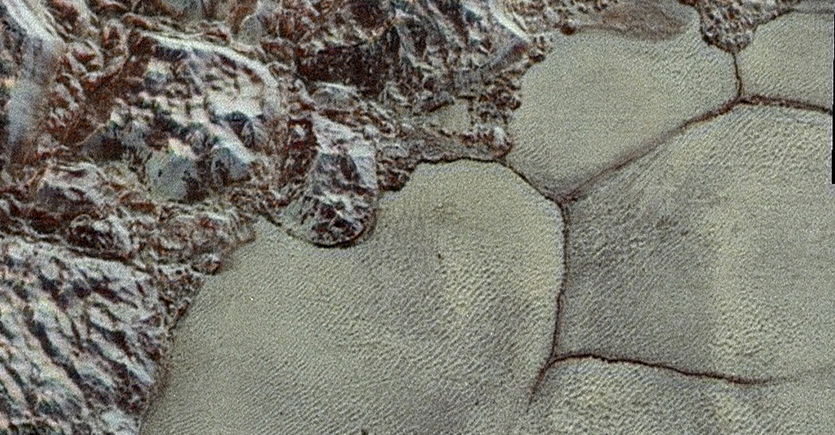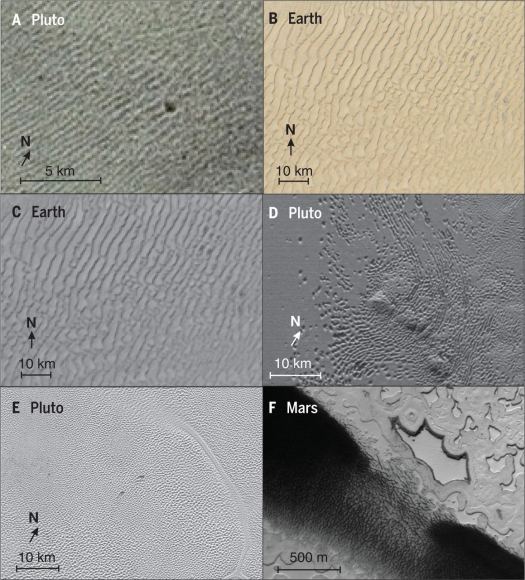"Sand Dunes" of Pluto consist not of sand - these are pellets of frozen methane
- Transfer

In July 2015, the New Horizons interplanetary station went down in history, having made the first flight past Pluto. In the process of flight probe collected mountains of data on the surface of Pluto, its composition, atmosphere and satellite system. He also gave us breathtaking pictures of Pluto’s “heart”, its frozen plains, mountain ranges and the mysterious “ barbed plain ”.
These strange features for the first time demonstrated how strongly the surface of Pluto differs from the Earth and other planets of the inner solar system. It's funny that they also showed how this distant world looks like Earth. For example, in a new study, a team of scientists who processed images obtained from the “New Horizons” noticed “dunes” on the surface of Pluto, resembling the sand dunes of the Earth.
The study was called “Dunes on Pluto,” and recently published in the journal Science. He was led by Matthew Telfer, a professor of physical geography from the University of Plymouth, and geologists Eric Parthele from the University of Cologne and Jani Radebaugh from the University of Brigham Young.

Small spots on Sputnik plain were recognized as transverse dunes due to their perpendicularity to dark “wind strips.”
They were assisted by members of the Carl Sagan Center from SETI, NASA Ames Research Center, Southwestern Research Institute, the National Observatory of Optical Astronomy, Massachusetts Institute of Technology, Laboratory of Applied Physics, Johns Hopkins University and many other universities.
Dunes on Earth are formed from sand blown off by the wind, creating repetitive ridges in the desert or along beaches. The same phenomena are observed along rivers and alluvial plains , where water leaves mineral deposits over time. In all these cases, the dunes appear due to the transfer of solid particles in a moving medium (in air or water). Outside the Earth, such phenomena were observed on Mars, Titan, and even on the comet Churyumov-Gerasimenko.
However, when studying images obtained from the New Horizons probe, Telfer and his colleagues noted similar formations on the Sputnik plain on Pluto. This region is the western part of the Tombo areaheart-shaped, in essence, is a massive reservoir of ice. Researchers have already noted that its surface seems to consist of irregular polygons delimited by depressions, which may serve as a sign of the presence of convective cells .
As Dr. Telfer explained to us by mail:
“Already in the first days, we noticed features resembling dunes, but over time and with more and more images, most of them became less and less convincing. However, one area became more convincing with each pass. It is about her that we report. ”
Another interesting feature is the dark streams several kilometers long, aligned in one direction. The features found by the Telfer team were just as interesting - they looked like dunes running perpendicular to the wind stripes. This indicated that the dunes are transverse - such as are caused by long winds in the desert. Images from the probe "New Horizons" demonstrate patterns on the surface of Pluto, which are considered dunes.

To determine the plausibility of such a hypothesis, the researchers built models that take into account the type of particles these dunes could consist of. They concluded that pellets subject to transport by typical winds could consist of methane or nitrogen ice. Then they modeled the physics of Pluto's winds, which should blow harder, descending from the mountain slopes surrounding the plain of Sputnik.
However, they also determined that the winds on Pluto could not be strong enough to move these particles on their own. In this process plays an important role sublimation- when the surface ice passes from the solid to the gaseous phase when heated by sunlight. Such a process would provide the force acting vertically upward, which is necessary for lifting particles from the spot, after which the Pluto winds could already carry them and spread them across the surface.
As Tefler explained, this conclusion was made possible thanks to the enormous support received by his team, most of which was provided by the team of geology, geophysics and the imaging of the mission “New Horizons”:
“After conducting a spatial analysis that convinced us that it could really be dunes, we had an excellent opportunity to work together with Eric Partheli from Cologne; he showed us on his models that such dunes should be formed only if the granules first rise into the air. The New Horizons team helped us a lot by pointing out that mixed nitrogen and methane ices should lift methane ice granules upward in the process of sublimation of ices. ” Comparison of the features of dunes on Pluto, Earth and Mars

This study demonstrated not only what Pluto, one of the most distant objects in the solar system, looks like on Earth, but also how active its surface is. “This shows us not only that the surface of Pluto affects its atmosphere, but also the opposite effect,” Telfer said. “We found a very dynamic surface of a planet so far located in the solar system.”
In addition, understanding how dunes can form in Pluto conditions will help scientists interpret similar features that they find in other places in the solar system. For example, NASA is planning to send a mission to Titan in the next decade.to explore its many interesting surface features, among which are the dunes. Also, many missions are sent to explore the Red Planet until people fly there somewhere in the 2030s.
Knowledge of how these formations appeared will help us understand the dynamics of the planet, and answer deeper questions about the processes occurring on its surface.
